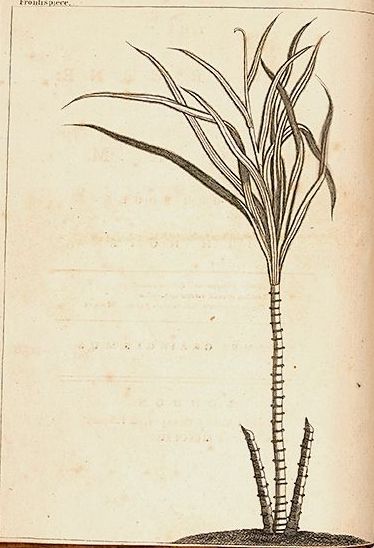Key Text: The Sugar-cane. A poem.
 Organized into four books of blank verse, James Grainger's 1764 The Sugar-Cane. A Poem was first published in London in 1764 and became quite popular, appearing in a second edition only two years later. In the poem, Grainger displays his admiration of the sugar cane plant and its product, sugar, and offers a detailed look into the life of the plant as well as the enthusiasm it generated among the people on the islands and in Europe. Trained as a physician, Grainger first came to the island of Jamaica in 1759 and spent time there offering medical care to its inhabitants. This is Grainger's only known work of natural history.
Organized into four books of blank verse, James Grainger's 1764 The Sugar-Cane. A Poem was first published in London in 1764 and became quite popular, appearing in a second edition only two years later. In the poem, Grainger displays his admiration of the sugar cane plant and its product, sugar, and offers a detailed look into the life of the plant as well as the enthusiasm it generated among the people on the islands and in Europe. Trained as a physician, Grainger first came to the island of Jamaica in 1759 and spent time there offering medical care to its inhabitants. This is Grainger's only known work of natural history.
Each book of the poem covers different aspects of the sugar cane's life, from the climate in which it thrives and the diseases, insects, and climates to which it is most susceptible. Books I, II, and II cover the sugarcane's production process, while book IV covers the examines the politics and culture of the sugarcane plantation. Book IV is significant to note for its discussion of the enslaved people living on the plantation. Grainger expressed views that, while by no means anti-slavery, showed a particular sympathy for the enslaved people working in the sugarcane fields. In fact, much of Book IV is dedicated to humanizing enslaved people and suggesting that they receive fairer treatment. Grainger even suggests what can be described as nearly voluntary enslavement as a way to ensure that well-being of the enslaved people, and grant them at least partial freedom. Grainger's solution suggests some sense of compassion for the enslaved people; however, he offers no feasible solution and uses his medical knowledge to affirm which African ethnic and tribal groups make for the best slaves. The cognitive dissonance displayed in the text is not unique, similar texts from this location and period (as found in our digital archive) express the desire humanize enslaved people all while exploiting them for their labor.
Although this the text features only a single image of the sugar cane, the image remains significant as the text went through several reprints, was often anthologized in its time, and continues to be a notable example of (in Grainger's own words) a "West-India Georgic"—a term that, as Elizabeth Polcha points out, "recalls Virgil’s Georgics, and also places the poem in the eighteenth-century British tradition of poetry which combined rural subject matter, Baconian science, and the representation of national identity." Its causal description as a georgic subtlety allows it to be absorbed into western literature. Again, we see the claiming of the indigenous' land and black bodies being claimed by the west in a way that is not only literal but also intellectually and philosophically. Additionally, to return to Dániel Margócsy's arguement about the commodification of the Carribean through image, given the wide circulation of Grainger's work, there is no doubt that it was heavily influential to European's understanding of the sugarcane, which of course was embedded with a lot of complicated, and contradictory, views on slavery.
The original printed text can be found in our archive here. A transcribed version of the entire poem (with notes omitted) can be found here.
